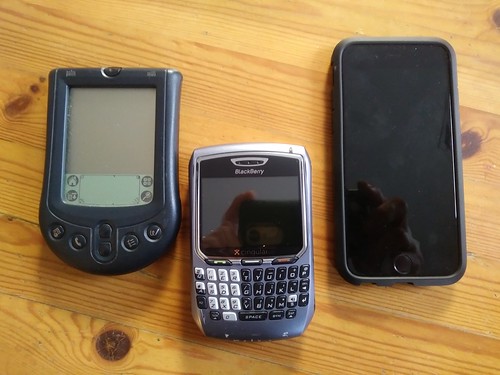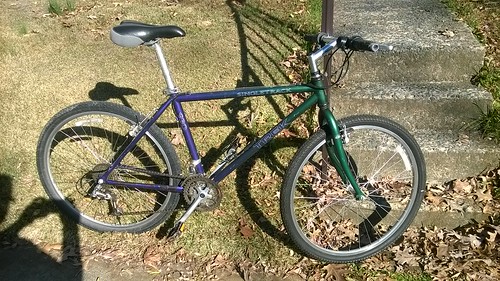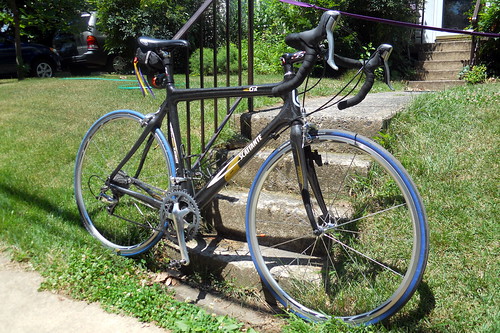
A point of comparison - 15 years (or so) of mobile computing devices
One reason I appreciate bicycles is that a good basic bicycle can be highly useful even if only slightly evolved from what was in use over 100 years ago.
By comparison, we have mobile computing devices, which are disposable units (although we see uhm I forgot to dispose of several) that provide useful service for at best four or five years. Further, while mobile commuting are evolving, not all the evolution is in a positive direction for many users. The 2001 (or so) Palm Pilot M105 was a cheap plastic device that required docking with a PC in order to upload/download messages but it weighed almost nothing and having no glass, was difficult to break (and if you did, it was so cheap, it didn't matter that much). I was actually fairly good with the "shorthand" to enter text with a stylus. The next step, a "traditional" 2005 or 2006 BlackBerry, was much more truly a mobile computing device but best for doing email with its "real" (tiny) keyboard - the size of the screen made Internet browsing painful - but then, that wasn't the point. Then we have a now-old(ish) iPhone 6 - the main thing I use it for is email, for which the keyboard is not great (for me; I realize some are good at it). The browser is good but not the main reason I have this device. And compared to the Palm Pilot or the BlackBerry, it is heavier as well as fragile with its sheet of glass. (Alas now I find it necessary some of the time to have both a work phone and a personal phone and the two of them together weigh 5/6 of a pound, which is annoying.)
Most importantly the two older mobile devices are simply unusable due to obsolescence. There is no comparison with a good bicycle!

A 1982 Bridgestone bicycle that I ride thousands of miles a year to and from work
About six years ago I bought the frame and fork for this Bridgestone on eBay for a little over $100 including the shipping. I then spent another ~$400 on a combination of used and new components to make it into an outstanding commuter bike. Other than the brakes I chose, which are a design introduced in the 1990s, nothing about the bike now represents a technological improvement over the bike as originally sold in 1982. I would be fine with riding the bike to and from work with the components that it had originally - that is, there is no way to regard any aspect of this bike as sold 35 years ago as obsolete. No one gives a second glance to this bicycle as they would if I tried to use my plastic Palm Pilot at a meeting at work, for example, or to use a different example, if I drove around in a 35 year old car.

Another ageless bicycle, a 1995 Trek SingleTrack
I purchased this bike two years ago from a bike repair "collective" (http://velocitycoop.org/ that had too many bikes and was selling excess - it cost $60 more or less as shown, except it was missing a saddle (seat) and only had one pedal. Well and it was incredibly filthy. I added a pedal and saddle and cleaned it and it was immediately ridable. While at the time this was a "low end" Trek bike, it was still significantly more expensive than many similar looking bikes one sees for sale today - the difference was that this bike was made with well thought out double butted chromoly tubing for the frame that means it only weighs 27 pounds (which is good). I have put studded tires on this for winter and it is a great bike for icy conditions!

My one perhaps mistaken concession to modern bicycle technology - sort of
I did buy this bike new in 2007 - it is a carbon fiber road bike and I ride it in good weather. Avoiding rain reduces maintenance and the bike doesn't have fenders anyway. It is nice, weighs just under 20 pounds, or about five pounds less than the Bridgestone above. The "technology" that is advanced for this bike is the use of carbon fiber for the frame, which at the time had a certain appeal to me that I still understand, but I wouldn't do it again. Carbon fiber is simply nasty to dispose of, although apparently the bike frame is unlikely to wear out - but eventually someone will dispose of it. And creating it in the first place was not a green process, either. Carbon fiber bike frames didn't render my steel bikes obsolete for commuting!
I doubt I will ever buy another new bicycle. New to me, perhaps, but not new-new. New technologies for bicycles are largely optional (if not also perhaps highly attractive/sexy to some people) such as hydraulic brakes or electronic shifting. No thanks.
No comments:
Post a Comment